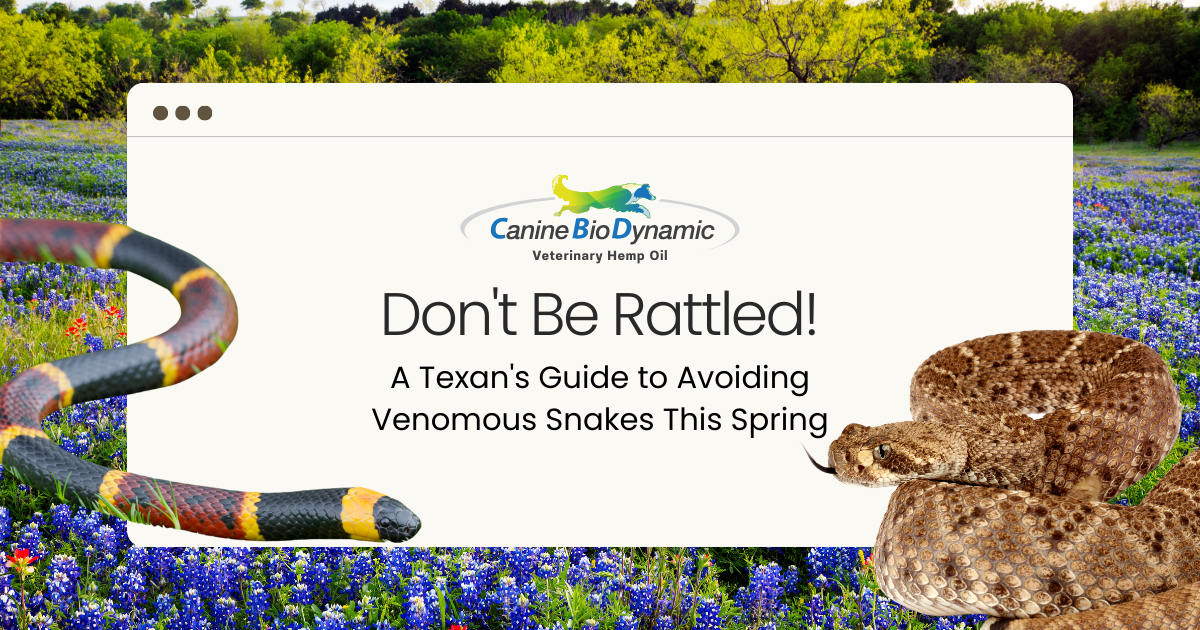Don’t Be Rattled! A Texan’s Guide to Avoiding Venomous Snakes This Spring
Don’t Be Rattled! A Texan’s Guide to Avoiding Venomous Snakes This Spring
Spring has sprung in Texas, bringing with it blooming wildflowers, baby bluebonnets, and…snake season! As the temperatures rise from their winter slumber, Texas’s many slithering residents become more active. While most encounters with snakes are harmless, it’s important to be aware of the potential dangers, especially for curious pets and young children.
Venomous Vipers: Who to Watch Out For
Texas boasts 15 species of venomous snakes, but four top the list for encountering humans:
- Western Diamondback Rattlesnake: This iconic rattler is easily identified by its rattle and diamond-shaped patterns. Found throughout the state, they prefer rocky areas and tallgrass.
- Broad-banded Copperhead: Look for the distinctive hourglass markings on this pit viper. They favor wooded areas, rocky outcrops, and brush piles.
- Cottonmouth (Water Moccasin): Semi-aquatic, these venomous snakes lurk near water sources like ponds, swamps, and rivers. They are easily identifiable by their broad, flat heads.
- Texas Coral Snake: Don’t be fooled by their vibrant colors. Unlike most venomous snakes in Texas, coral snakes lack a rattle and have red bands touching yellow bands.
Why Baby Snakes Are a Big Threat
While smaller, juvenile snakes can be just as dangerous, if not more, than adults. Their venom glands are fully developed, and they may be quicker to strike due to their inexperience.
What to Do if Your Dog Gets Bitten
If you suspect your dog has been bitten by a venomous snake, stay calm and take immediate action:
- Remove the dog from the area: Limit further movement to prevent the venom from spreading.
- Do not apply a tourniquet: This can cause more damage.
- Keep the bite wound still and below the heart.
- Transport your dog immediately to a veterinarian.
Snake Havens: Where They Like to Hide
Knowing where snakes like to hang out can help you avoid unwanted encounters. Here are some common snake hideouts:
- Rock piles and crevices
- Brush piles and overgrown areas
- Woodpiles and lumber yards
- Around and under buildings
- Near water sources
Keeping Your Yard Snake-Free
Here are some tips to make your yard less attractive to snakes:
- Minimize clutter: Remove piles of leaves, brush, and debris.
- Keep your lawn mowed: Short grass offers less hiding cover.
- Seal up entry points: Caulk cracks around your foundation and repair damaged screens.
- Store firewood away from your house.
- Consider a fence: Solid wood or metal fencing can deter snakes, though determined ones can find ways in.
Why Spring is Snake Season
Spring brings warmer temperatures, coaxing snakes out of their winter dens. It also coincides with mating season, making them more active in search of mates. Additionally, the spring growth creates a surge in rodent populations, a major food source for snakes. This increased activity makes encountering snakes more likely in the spring months.
Respectful Coexistence
By understanding snake behavior and taking preventive measures, you can minimize the chances of a negative encounter. Remember, snakes play a vital role in the ecosystem by controlling rodent populations. If you see a snake in your yard, the best course of action is to leave it alone and allow it to move on. If you’re concerned about a snake in your home, contact a professional wildlife removal service.
With a little knowledge and caution, you can enjoy the beauty of spring in Texas without any unwanted scaly surprises.
P.S. Call Dr. D at 512-413-2349 or visit https://caninebiodynamic.com/store/ for more information on this topic or to discuss how CBD can benefit your pet.
XOXO,
DrD



Excellent information. Thank you for the detailed information on what’s going on in our yards.
Great write up and very informative!
This is good. Thanks hit the tips on what to do if my dog is bitten.
Great info! I will share this will my pet owner friends!